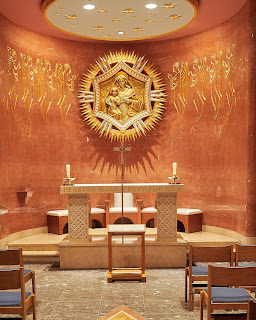Ez 37:12-14
Ps 130
Rom 8:8-11
Jn 11:1-45
In the context of today, the readings and the responsorial psalm are both a reminder and a consolation. The modern world is being forced to confront the reality and unpredictability of illness and death, a reality that was more familiar during times of plague throughout history before the discovery of antibiotics and other health measures. Even as recently as a century ago the Spanish flu, reminded the world, still in throes of recovering from WW I, of fundamental realities. Since 1919 medical progress has resulted in a life expectancy that shot up from 49 years of age to almost 80 years of age. With progress however, comes new complications and new risks.
Ezekiel begins with a promise:
"Thus says the Lord God:
I will open your graves
and have you rise from them."
The Jewish Study Bible gives interesting commentary on this passage: “Traditional Jewish scholars find in this passage, the idea of the resurrection of the dead before the day of judgment. This was a fundamental belief of rabbinic Judaism attributed to Moses.” Obviously the idea of the resurrection of the dead is not a new belief that emerged in Christianity. But, even within ancient Judaism the resurrection of the dead was not universally accepted or believed. While the Pharisees believed in the resurrection of the dead, the Sadducees did not. This raised some complex dilemmas in other gospel narratives.
The responsorial psalm, Psalm 130 known as De Profundis from the first two words in Latin, is a psalm for today. It is one of the most beautiful and evocative psalms in the entire psalter.
De profundis clamavi ad te, Domine:
Domine, exaudi vocem meam.
Out of the depths I cry to you, Lord.
Lord, hear my voice.
We call to the Lord out of the depths of our anguish, our current world anguish and the anguish we've experienced over the years and decades, the personal and private pain we may or may not be able to share with others. We call from the tomb--self-imposed and imposed upon us--in which we find ourselves again and again. The psalm reminds us that we call to the Lord who hears our plea; the Lord who forgives our sins. We wonder if we can forgive ourselves or others. We implore the Lord for the optimism of a new day, a new dawn, that we eagerly await. Psalm 130 is short, a mere eight verses. Read it and meditate on it.
The readings and psalm prepare us to hear the cinematically detailed story of Lazarus. It is not only the story of Lazarus. It is our story. It is the revelation of being brought from death to life in Christ through the forgiveness of sins until the final resurrection of the dead.
Jesus, fully human, weeps at Lazarus’ tomb. Jesus, fully God commands Lazarus to come forth from that tomb. This same Jesus, fully human, wept over Jerusalem as he weeps over us. This same Jesus, fully God, called the son of the widow of Nain to rise from his stretcher and the daughter of the official to get up from her bed, just as he calls us to eternal life.
In his commentary on this Gospel the late Jesuit Father Stanley Marrow points out the fundamental difference between Lazarus, the son of the widow of Nain, the daughter of Jairus; and Jesus. If one were forced to choose only two words to describe that difference they would be reanimation and resurrection. Lazarus, the widow’s son, and the young girl were reanimated for a period of time, only to die later. Miraculous? Yes. It is not unlike the modern miracle of cardiac resuscitation or the miracles wrought daily in hospitals throughout the world. We can and do bring people back from that edge, even when they seem to have crossed it. However, these are temporary stays of death at best. Only Jesus was resurrected from the dead never to die again.
If Lazarus is us so is Martha. The same Martha who complained to Jesus about Mary's inactivity in Jesus' presence now makes a profound act of faith, “Lord, if you had been here, my brother would not have died. But even now I know that whatever you ask of God, God will give you.” And then the climax of this narrative:
“I am the resurrection and life;
whoever believes in me will live,
and everyone who lives and believes in me will never die.”
It is not that we will not die to this life. Jesus is not promising that we won’t become ill and suffer. Our deaths may come quickly without time to prepare. Our deaths may signify the end of a slow but easy passage from this life; a deep sigh at the end and nothing more. Or we may die after a prolonged period of pain, suffering, and decay. The mode of death is not ours to choose, particularly in the planned killing of the sick elderly or the unwanted child. What Jesus is promising is that, in Stanley’s words, “the eternal life which we possess here and now cannot and will not be interrupted even by death.”
We cry to the Lord out of the depths.
The Lord answers with kindness and plenteous redemption.
What more could we want?
The cross on top of sv. Višarje, a site of pilgrimage in the Julian Alps in Italy, barely across the borders with Slovenia and Austria. It recalls the motto of the Carthusian Order. Stat Crux Dum Volvitur Orbis (The Cross Stands Firm While the World Turns)
There are Carthusian houses in all three countries.
+Fr. Jack, SJ, MD


